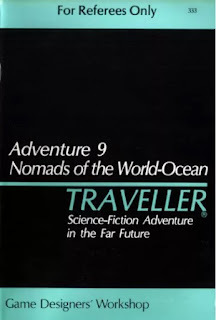Retrospective: Nomads of the World-Ocean
 I recently mentioned that I'd be devoting more space on this blog to coverage of Traveller. I thought a good way to start making good on that pledge is using my weekly Retrospective to draw attention to some of my favorite Traveller products, since Game Designers' Workshop published a large number of excellent adventures and supplements for the game. They're not all winners, of course, but I do think that Traveller had a higher ratio of good to bad support material than many of its contemporary RPGs.
I recently mentioned that I'd be devoting more space on this blog to coverage of Traveller. I thought a good way to start making good on that pledge is using my weekly Retrospective to draw attention to some of my favorite Traveller products, since Game Designers' Workshop published a large number of excellent adventures and supplements for the game. They're not all winners, of course, but I do think that Traveller had a higher ratio of good to bad support material than many of its contemporary RPGs.A good example of what I'm talking about is 1983's Nomads of the World Ocean, written and illustrated by the incomparable Keith Brothers. I'd previously mentioned this adventure, the ninth published for Traveller, in my list of the Top 10 Classic Traveller Adventures, where it ranked as number 4. I still think that's a fair judgment, because, while very well-done, Nomads of the World-Ocean is also a very specific kind of scenario and, therefore, might not hold a wide appeal.
The adventure takes place on Bellerophon, a world in the Solomani Rim subsector. As its title suggests, Bellerophon is a water world whose only dry land are a few scattered islands and reef-flats exposed at low tide. Despite this, the planet boats a population of over 2 billion humans, most of whom live on magnificent pylon cities that rise from the ocean shallows, thrusting two or three kilometers into the sky. There are also sea-bottom complexes and free-floating raft cities, as well as a considerable population of the titular nomads, who live aboard large ship-cities that follow herds of marine creatures called daghadasi that provide them with a livelihood.
Like many classic Traveller adventures, the characters come to Bellerophon as agents of an outside organization, sent to investigate the activities of a corporation that operates on the planet. In this case, the corporation, Seaharvester, is culling the population of daghadasi in order to obtain a chemical produced by the animals in their pre-reproductive phase. This chemical has proven to be the basis for an entirely new family of drugs that have the potential to wipe out bacteria, viruses, viroids, and even cancer cells. Unfortunately, a daghadasi carcass weighing a million tons yields only a few grams of the chemical. Worse, only about 10% of all slaughtered daghadasi produce more than trace amounts of it, necessitating massive, indiscriminate slaughter to procure this valuable new chemical.
When evidence of Seaharvester's actions became known, public opinion turned against them and its parent company, SuSAG, one of the Imperium's megacorporations, placed limits on their culling of the daghadasi. However, there's evidence that Seaharvester has been skirting these limits and it's now up to the characters to prove it. The adventure presents two options to involve the characters. One assumes they're working for an environmentalist group, the Pan-Galactic Friends of Life, while the other assumes they're employed by SuSAG itself, looking to save its reputation.
What makes Nomads of the World-Ocean special isn't this set-up but the world of Bellerophon itself. Everything about it is described in loving detail, with plenty of hooks for interesting encounters, side adventures, and exploration. The Keith Brothers give us information on the pylon cities, Seaharvester's factory ships, the lifecycle and ecology of the daghadasi and, of course, the nomads themselves. As one might expect, the nomads receive the greatest amount of detail, since they hold the key to proving the continued malfeasance of Seaharvester.
The nomads live on wandering ship-cities of 1000-5000 people. Their society and indeed livelihoods depend on the kilometers-long daghadasi, whom they sustainably hunt to provide not just food but also materials for the manufacture of other items that they trade. The nomads are a highly technological society. Their ship-cities, for example, make use of fusion power, as do the various smaller craft they use in the hunting of the daghadasi. Though they share a common language and culture, the nomads are divided into factions, based in part on their attitudes toward outsiders and the traditional ways of their people, which is now under threat from Seaharvester. A significant portion of the scenario involves the characters having to navigate nomad politics to achieve their own ends.
Nomads of the World-Ocean is a great example of something classic Traveller did very well: present a single world out of the 11,000 that make up the Third Imperium and showing that it alone is more than sufficient to occupy the characters' attention for weeks or even months of gameplay. One of the paradoxes at the heart of Traveller is that, as its name suggests, the characters are assumed to move around a lot from world to world and even sector to sector, never staying in one place for very long. Yet, each and every world they visit is – or can be – a setting in itself. Balancing the characters' ability to travel easily across Charted Space with giving each world its own unique appeal isn't always easy, which is why I so highly regard adventures like this one. Nomads of the World-Ocean is a terrific example of Traveller at its best.
Published on December 04, 2024 21:00
No comments have been added yet.
James Maliszewski's Blog
- James Maliszewski's profile
- 3 followers
James Maliszewski isn't a Goodreads Author
(yet),
but they
do have a blog,
so here are some recent posts imported from
their feed.



